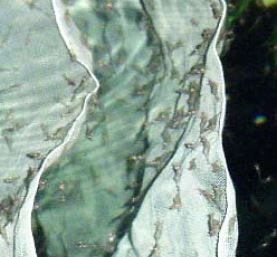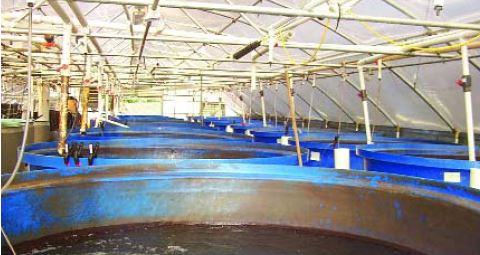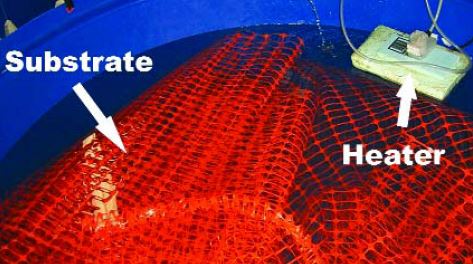5 Postlarval holding and nursery phases
5.1 Basic requirements and facilities
The selection of sites for indoor nurseries should follow the same pattern as for hatcheries.
Site selection for outdoor nursery facilities should be similar to that for grow-out ponds.
HOLDING TANKS
After rearing your freshwater prawns in your hatchery, you need to be able to hold them until you stock them in your ponds or sell them to other people. 50 m3 concrete tanks are convenient for holding postlarvae (PL) prior to transport for stocking in ponds. However, you can also use other sizes and types of tanks, similar to hatchery tanks. There are no special requirements, except that they must have supplies for freshwater and air. You can use branches and nets suspended from floats in the tanks (both referred to as ‘substrates’ in this manual) to increase the surface area available to the PL but this may make the normal operations of feeding, cleaning etc. (similar to hatchery operation) more difficult.
Figure 37 shows PL utilising a nylon screen inside a holding tank.
INDOOR (PRIMARY) NURSERY FACILITIES
Tanks for indoor freshwater prawn nurseries (Figure 38) can be constructed from concrete or fibreglass. The use of asbestos cement tanks is not recommended. The shape of nursery tanks is not important and their size, usually from 10 to 50 m2 with a water depth of 1 m, depends on the area of the outdoor ponds which you (or those you sell juveniles to) are eventually going to stock with your product. You can use artificial substrates of various designs and materials to increase surface area; these provide shelter and increase survival rates.
Prawns tend to use the edges of substrates, whether they be natural (e.g. leaves, branches) or artificial. Layers of mesh can therefore be used to increase the amount of surface edges available to the prawns in both vertical and horizontal planes (Figure 39). Plastic
Figure 37
Postlarval freshwater prawns can use a nylon screen as an additional surface area in holding tanks (Brazil)

SOURCE: EUDES CORREIA
netting can be placed in several layers over wood, aluminium, or PVC pipe frames. Suspend these 10 cm above the bottom of the tank, so that it can be cleaned. Hanging the mesh vertically allows the prawns easy access to the tank bottom to search for feed and allows detritus to fall to the tank bottom, where it can be siphoned out.
Other substrate designs are feasible but you must be careful to think about the effect of the substrates that you use on your ability to manage the tanks (feeding, observation, cleaning, etc.).
The water supplies for indoor nurseries can be flow-through or recirculating. For flow-through, allow the water to continuously enter from above the tank water level and exit from the lowest part of the tank through a vertical standpipe with an outside sleeve (pipe with a larger diameter) extending higher than the water surface. Cover the standpipes with a 1.0 mm mesh screen to prevent PL and juveniles from escaping. This drainage system draws water from the tank bottom where food waste and detritus settle.
If you wish to operate your primary nursery tanks on a recirculation system it can be similar to those used in recirculation hatcheries.
OUTDOOR (SECONDARY) NURSERY FACILITIES
Nursery ponds are similar to grow-out ponds in design and facility requirements; these are described later in this manual. They usually vary in area from 300 to 2 000 m2. Some operators cover their nursery ponds with plastic netting to avoid predators, especially dragonflies, whose nymphs predate on freshwater prawn PL. Do not fill the ponds earlier than 2 days before PL are stocked; this will prevent such predators becoming established before the prawns arrive. You can use artificial substrates to increase the surface are available to the prawns, as described in the manual section on grow-out in temperate areas. Make sure
Figure 38
Overhead air and water distribution systems are used to supply these indoor nursery tanks (USA)

SOURCE: CHARLES WEIBEL
Figure 39
Substrates can be used in nursery tanks to increase the surface area available to juvenile prawns; this substrate consists of the material used to make barriers around roadworks (USA)

SOURCE: CHARLES WEIBEL
that ponds are treated between cycles, as described in the section on grow-out. Figure 40 shows an internal turn-down drain in use during pond draining and sediment removal.
NURSERY CAGES
Postlarvae can also be nursed in cages but research on the best ways to manage cages for this purpose is not yet complete enough to recommend this in this manual. The scientific literature describes (for example) the use of 1 m2 cylindrical cages constructed from 0.64 cm mesh galvanized hardware placed in the mud bottom of a pond (although these were described as cages, they are really pens). In this case, animals weighing almost 2 g were stocked. PL or juveniles would require a much smaller mesh size. 2 x 1 x 1 m cages made of iron with a 1.0 mm nylon mesh, suspended above the pond bottom (real cages) have also been described for stocking PL. Such fine mesh would need careful cleaning to ensure proper water exchange and the mesh size would need to be increased as the animals grow.